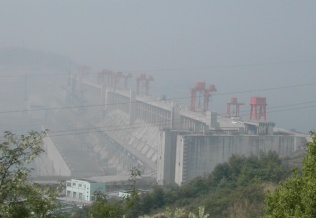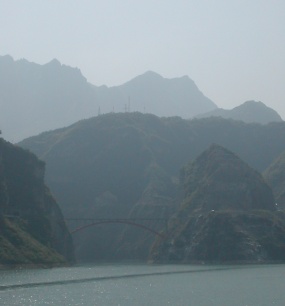YANGTSE RIVER
One of the first things we learned about the Yangtse River is that its name is actually the Chang Jiang River. The Yangtse is a local name for the eastern end of the river around Shanghai. However, ‘Yangtse’ somehow found its way in to popular use among westerners to describe the entire river, so it is often used. The Chinese, however, refer to the river as the Chang Jiang. We are westerners, so we will continue to use Yangtse.
We also quickly learned that the Yangtse is almost 2,500 miles long. It is the third longest river on the planet.
We boarded the Victoria 5 for a four day trip up the Yangtse River. Until June, 2006, ships embarked their passengers in Yichang – slightly south of the Three Gorges Dam – and passengers would experience transiting the locks. However, at present, work is being done on the dam’s locks, and in an effort to minimize traffic through the locks, ship passage has been restricted to commercial freight vessels only. So, we explored the Three Gorges Dam by land before heading up the river.

Barely visible through the air pollution
This is a huge project! The dam itself entails the largest lock system in the world, and the rising water level has required the ‘relocation’ of millions of people. Nearly 10% of the planet’s population is affected by this dam.
The dam, started in 1993 and due to be completed in 2009, is 600 feet high and more than a mile across. It was built to provide badly needed hydroelectric power and control flooding in the lower river area. However, it is not without critics or problems.
The dam is raising water levels by 575 feet in nearby upstream areas. As the upstream waters rise, millions of people have had to be relocated. Rising waters have flooded ancient cultural ruins as well as modern cities. Also, as the water rises upstream of the dam, it lowers downstream. Consequently, cities that have long used the Yangtse to flush away their sewage and waste are now developing gigantic cesspools where the waters used to run. The reduced water flow downstream has also created silting problems in adjoining waterways, and some fish and dolphin species are likely to be forever lost.
The dam has a five-level double ship lock that is more than a mile long and raises/lowers a ship 370 feet. There is also a ship lifting tower intended to quickly raise/lower ships less than 80 feet in length; however, it has had some ‘design problems’, and it has not been operating. Approximately three hours is required to transit the locks.
The dam is producing only a small percentage of the power it is hoped to produce. However, power production is expected to increase markedly upon completion.
The three gorges – from east to west – are Xiling Xia, Wu Xia, and Qutang Xia. The Xiling Xia was previously the most treacherous stretch of the river to travel, and it is now lake calm. All three gorges are scenic, but the Qutang Xia is the most scenic – unfortunately, it is also the shortest. Most of the land on the banks is rugged and unused; however, there are occasional settlements. These are not small quaint villages, but rather settlements of hundreds of thousands of people as well as industry to provide work. Large coal mines continue to operate along the river.
We both got sick during this phase of our trip, so we started doing a few things individually as we felt up to it. Bud did a few things without Nita and vice versa.
Bud took a side trip up the Shennong Stream, a very beautiful tributary at the eastern end of the Wu Xi, which included being pulled up part of the way by trackers. Trackers are men who, wearing harnesses, literally pull a boat up river over rapids that it otherwise could not go. Upriver on the Shennong are remnants of some hanging coffins that were mortised in to the gorge walls more than 1,000 years ago. Then the trackers expertly guided the boat down an exhilarating ride through the rapids.

The river is now calm as a lake
Another side trip we took was visiting the relocated city of Fengdu (relocated from the north bank to higher ground on the south bank because of rising water). We were expecting a small village of a few thousand people. It is a high rise mass of over one million people with industry and infrastructure to support them. This was when we started getting a grasp on the magnitude of the relocation necessitated by the Three Gorges Dam.
Fengdu also has a Ghost City on the otherwise-abandoned north bank. It is high enough on the bank that it will not be flooded by the rising waters. It could have been ‘just another temple’ except for its museum of horrors. It had a display of a few hundred wax human figures – each about 1 foot tall – experiencing some of the most hideous torture imaginable. We will spare you pictures, but it was extremely gruesome.
But after four days and nights on board, it was time to move on. We disembarked in Chongqing.